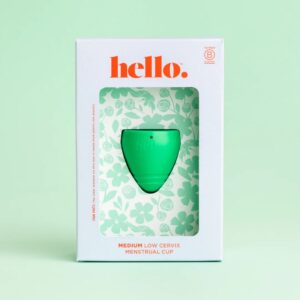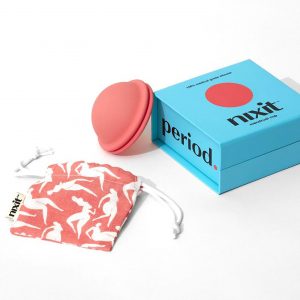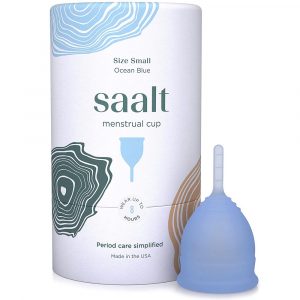How to Check Your Cervix Position: Low vs. High Cervix
Your cervix position is a major factor in which menstrual cup you should purchase

Learning how to check your cervix position will help you determine which menstrual cup length and shape to choose, as well as whether or not you should trim the stem. It can also be helpful to determine when you are ovulating and the state of your reproductive health. Below we will discuss some simple guidelines for locating your cervix.
Where is the cervix?
The cervix is the vaginal opening that leads to a women’s reproductive system, allowing sperm to travel through and fertilise eggs. Your cervix is positioned at the end of your vaginal canal (usually around 7.5 to 15cm inside the vagina).
Imagine a long hallway with a door at the end – that’s what the cervix looks like. It attaches to the vaginal wall and is sometimes described as feeling like the tip of your nose and in the shape of a doughnut. Where the vaginal canal is soft, the beginning of the cervix feels firm.
Note: If you currently have a yeast infection or any other form of vaginal infection, it is best not to check your cervix until this is all cleared up. Unusual vaginal discharge is usually a sign of infection. In addition, menstruation, sexual arousal, and early pregnancy may result in cervix changes too.
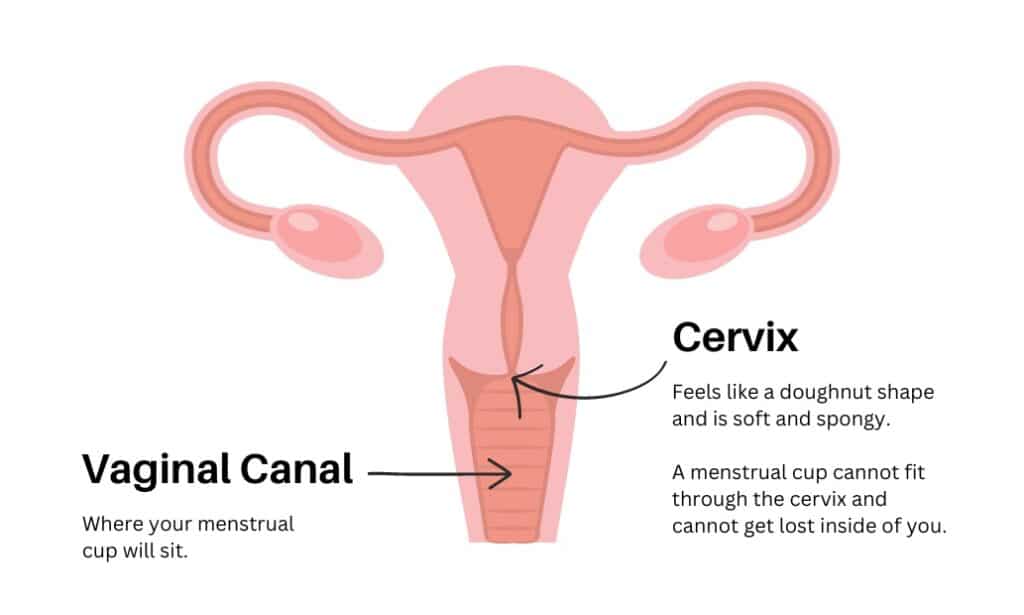
When should I check my cervix?
Your cervix height will change throughout your menstrual cycle, often being higher when you are ovulating and then lower during menstruation. To get an idea of whether you have a low or high cervix for the purpose of choosing a menstrual cup, you are best to check your cervix a few times during your period. This can be done in the shower to reduce mess and will help you determine an average position. Sometimes the cervix will change from a high to low position during your period. This is completely normal and may help solve why a cup works for half of your period and not the other.
Do not check your cervix before, during, or after sexual intercourse as arousal can affect position.
Step-by-step guidelines for checking your cervix position
1. Wash your hands thoroughly
Not much explanation is needed here. You will be inserting your fingers into your vaginal canal, so wash your hands to reduce any chances of introducing infection. Do not apply any moisturisers to your hands before feeling for your cervix. You may also want to consider trimming your nails if they are long in order to avoid potential scratches – ouch!
2. Find a comfortable position
Some of the best positions for checking your cervix are either squatting, sitting on the toilet, or raising one leg and resting it on the toilet seat, edge of the bathtub, or a chair. Whichever position you get into when inserting a tampon or menstrual cup is probably your best option.
3. Gently insert your finger into your vagina
Use an inwards and upwards motion and move your finger in as far as it will go. You will know when you are touching your cervix, as your finger will not be able to reach any further. You will also feel the firm doughnut shape of your cervix. If you are ovulating, your cervix will most likely be located higher. It will then be located lower once you have finished ovulating.
4. Use the knuckle rule to measure your cervix height
1st Knuckle = Low Cervix
If you are touching your cervix by the time your first knuckle enters the vaginal opening, then consider your cervix low. In this instance, trimming the the stem of your cup may be enough to make it fit comfortably. We do not recommend doing this until you are confident in removing your cup since your cervix may move higher up during your cycle. If trimming the stem doesn’t work and your cup continues to slip out, you may need to select a shorter or low cervix cup.
2nd Knuckle = Average Cervix
If you are touching your cervix by the time your second knuckle enters the vaginal opening, then consider it an average height. You should be able to comfortably wear most standard length menstrual cups without issue.
3rd Knuckle = High Cervix
If you are touching your cervix up to or beyond your third knuckle, or if you have trouble reaching it at all, then consider yourself to have a high cervix. Try to position your menstrual cup lower in your vaginal canal. It may travel up the canal a bit, however, this just makes it a little trickier to remove. With practice, it shouldn’t cause you any long-term grief or difficulties. We would also highly recommend trying a longer cup to make removal easier.
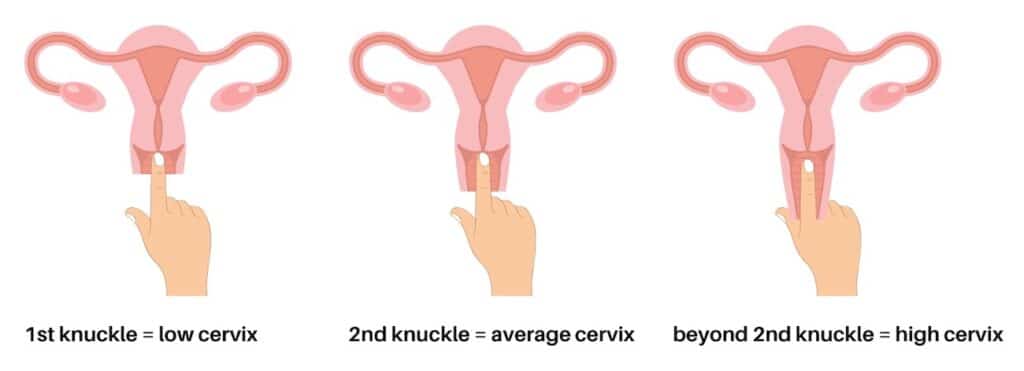
5. Choose a cup based on your cervix height
Once you know what height cervix you have, you will find it easier to choose the correct length of menstrual cup. If you have a cup that continually falls out, then it is possible the cup is too long and you need a low cervix cup. If you have difficultly reaching your cup to remove it, then you likely have a high cervix and should opt for a longer cup. Menstrual discs are suitable for any cervix height as they tuck up behind the pubic bone and are less likely to slip down or travel up the vaginal canal.
-
Nixit Menstrual Cup
$ 74.95Original price was: $ 74.95.$ 69.95Current price is: $ 69.95.Rated 4.50 out of 5
Why should you check your cervix position?
Checking your cervix position allows you to ensure the cup fits and helps prevent buying brands that don’t work for you. It also makes you aware of what your cervix normally feels like so you can identify concerning cervical changes such as polyps, cysts and scars. Furthermore, it can help you monitor the different phases of your menstrual cycle. It’s advisable to consult a gynaecologist or healthcare professional even if you notice seemingly subtle changes in your cervix.
Frequently asked questions:
Learn more about finding your cervical position in the FAQs below.
You can tell if your cervix is high or low by inserting one or two fingers into the vagina to try and feel for the cervix. If you can touch your cervix by your first knuckle, you have a low cervix. Alternatively, if you only reach your cervix after your second knuckle it means you have an average to high cervix.
Your cervix might be low due to menstruation, pregnancy or childbirth. In addition, the pelvic muscles often become weaker with age, causing the cervix to become lower over time. Women experiencing menopause also typically have a lower cervix due to having less oestrogen.
You can tell if your cervix is high or low by inserting one or two fingers into the vagina and feeling for the cervix. If you can reach the cervix by your first knuckle, your cervix is low. If you can reach it by or beyond the second knuckle of your finger, your cervix is average height or high.
If your cup slips out or cannot be completely inserted, this may be a sign that you have a low cervix and need a shorter cup.
If you are having trouble reaching your cup to remove it, then you most likely have a high cervix. Look for a longer cup to make removal easier.
Yes you can. Menstrual discs stay in place by tucking up behind the pubic bone. This means they do not travel up and down the vaginal canal like a menstrual cup can, and are therefore suitable for any cervix height.
Learn more about choosing the correct menstrual cup:
Menstrual Cup Sizing Guidelines
Menstrual Cup Sizing – which size cup do you need? This article is for anyone who is confused about which size menstrual cup to buy. While each brand of menstrual cup may differ slightly, when it comes to sizing your menstrual cup, there are five main factors to consider. 5 Menstrual Cup Sizing Tips While
Which Menstrual Cup?
Deciding which brand of menstrual cup to buy can be daunting. While many women will have success with any brand of cup, there are some instances where it may be a case of trial and error. Or, depending on cervix height and your level of menstrual flow, there may only be a couple of suitable
Top 5 Menstrual Cup Brands as Reviewed by MCA Online Customers
We have compiled a list of the top 5 menstrual cup brands currently sold on our website. We have chosen each one according to sales, number of customer reviews, and average 5 star rating, however, the ranking order does not particularly indicate that one brand is better than the other. These are simply the 5

